Crohn's disease is a type of chronic Inflammatory Bowel Disease (Vanni Pitham) which is a condition mentioned by Sage Yugi in Siddha literature. This case study describes a 11-year-old female, a known diagnosed case of Crohn's disease, who failed to enter clinical remission despite standard medical therapy for 2 long years. Patient was experiencing periods of moderate abdominal cramps with vomiting and pain along with frequent diarrhoea and later on constipation, loss of appetite and weight loss from Oct, 2020. Patient also reported occasional joint pains and delayed growth milestones (in terms of height and weight). The Harvey-Bradshaw Index showed value 7 which shows mildly moderate condition of disease so depending upon severity, the patient was treated with Siddha Thodu Varmam methods and Thokkanam Therapy along with some diet modifications for 15 sessions with a gap of 5 days between each session.
After the sessions, a vast improvement was observed in symptoms, activities, pain intensity and Quality of life of the patient measured by Harvey-Bradshaw Index (HBI) score, Quality of life (specific to Crohn's disease) & Visual Analogue Scale (VAS). CDEIS (Crohn's Disease Endoscopic index of Severity) was also measured which clinically confirmed about clinical remission in follow-up colonoscopy without need for medications and showed no signs of CD.


Crohn's disease, a type of chronic Inflammatory Bowel Disease (Vanni Pitham) mentioned by Sage Yugi in Siddha literature is characterized by Inflammation and Ulceration in Terminal Ileum and colon, although it can affect any part of the Intestinal canal [1]. Crohn's disease is usually classified as mild-to-moderate or moderate-to-severe [2]. Etiology of the condition is uncertain & it is thought to be provoked by a combination of genes, diet and environmental changes, immunity, and an abnormality of gut bacteria [2]. Records show recurring flare ups in CD, followed by periods of inactive disease and remission, with variable duration and intensity [2]. Studies show that the majority of patients do not achieve prolonged and complete clinical remission [3]. In recent times, data shows there is rising incidence and prevalence of Crohn's disease in India topping the Southeast Asian (SEA) countries, mainly due to unhygienic conditions and geographical location [4]. In case of India, there appears to be a North-South divide with more ulcerative colitis (UC) in north and Crohn's disease, more presence in the southern part of India. It can affect anyone but studies shows its prevalence more in young adults and adolescence with more of female domination and higher mortality rate among them [5].
In CD, Modern medicine provides resolution to acute flare-ups and at times subsides its affects for reasonable amount of time but are not 100% curative [6]. Clinical manifestations of CD including intestinal (i.e diarrhoea or constipation, abdominal pain/swelling, ulcers) and extra-intestinal (i.e. peripheral arthritis, aphthous stomatitis, uveitis, and erythema nodosum) causes fatigue and weakness among patients [7, 17]. A person can have excruciating pain or so many bowel movements a day that they can't leave the house and thus feels disruptive in their daily lifestyle. Reports show flaring of symptoms frequently has caused patients having psychological depressions affecting their work performance and Quality of life (QOL) [8].
In recent times, Siddha therapy, an ancient traditional therapy is gaining popularity all over Southern part of India for diseases like Irritable Bowel Disease, CD. Siddha system is bestowed with various special therapies of few which are Pressure Manipulaiton Therapy (Varmam), Physical Manipulation Therapy (Thokkanam), Pranayamam and Yoga that have proved to be beneficial in managing the symptoms of such chronic disease like CD [13]. Few studies have shown vast improvements in intestinal disorders and spinal issues by Thodu Varmam therapy [14]. Varmam therapy is a drugless, non-invasive, simple therapy used in pain management by pressing, massaging, tapping & lifting. In Siddha, the therapeutic stimulation of specific energy points (Thodu Varmam – junction of muscles, nerves, veins, arteries, capillaries) where the pranic energy or vital energy is stored through which energy is transmitted to various parts of the body and all the functions of the body are mediated. These points when stimulated increase the flow of energy, heal disease or boost the immune mechanism. Thokkanam is one of the 32 external therapies in Siddha concurrent to pressure manipulation therapy where external pressure is applied [15-16].
Our aim of presenting this case study is to see whether “Siddha therapy is affective on pain and symptoms of Crohn's Disease, remission and its impact on Quality of Life of the CD patients” which was determined by using HarveyBradshaw Index (HBI) score, SIBD Scale related to Quality of life, VAS scale, and CDEIS while adhering to the Guidelines adopted for practice of Siddha Varmam Therapy. It is important to elaborate the Crohn's disease, a type of IBD (Vanni Pitham, mentioned in the Siddha literature), to get a better insight of the disease and valid explanation; so that this study might form the basis for the management and treatment of the CD in future including the validation of the literature.
A 11-year old female with a 2 year history of Crohn's Disease (CD) presented herself in Chakrasiddh Centre in June, 2022 with moderate and persistent flare of her disease symptoms. She appeared pale, fatigued and anaemic. She had the complaints of intermittent, mild to moderate pain 4.9/10 occurring for 1-2 minutes, about 2 times per day. Pain usually presented either prior to, or post meals, and was relieved by belching, passing gas or defecation. Due to continuous medications, she does not suffer from watery stools but has developed constipation. She is having acidity issues and there was a C/O smelly perspiration too. She felt flaring of her joint pains sometimes especially in her feet, toes and hands, with sounds coming on movements. Patient also reported eczema at certain places which were itchy, uneven and noticeably increasing at other places too. Her hunger pangs were normal but if there was a delay in meals, there was a sense of nausea and vomiting. The patient had light sleep due to nasal congestion and sometimes due to discomfort in abdominal region.
The issues also affected normal growth patterns and were reflected as a delay/lag in the child's weight and height chart for age (Table 1). This was causing a concern to her parents as the child was losing her confidence, had low energy and was stressed out. On doing physical examination and based on radiological reports, the patient was diagnosed as Crohn's Disease- a type of Inflammatory Bowel Disease (Vanni Pitham) a condition mentioned in Siddha Medicine. The case was taken up for Complete Spine with Gut for 15 sessions with 5 days gap in between and with strict dietary modifications.
Patient was apparently healthy 2 years back, when she started complaining of moderate to severe, intermittent abdominal pains in periumbilical area with a severity of 6-8/10 with frequency of 7 to 8 times/day and for 1-2 mins. Patient experienced pain along with frequent watery diarrhoea and loss of appetite at start of disease thus had severe weight loss in last one year (5-6 kgs in last 3 months). Her BMI chart showed sudden fall in values in 2020, Nov (Figure 1). She was advised by her Paediatrician to visit a Gastroenterologist and go for Lab tests to diagnose her condition.
Laboratory Investigations revealed decrease in Hb level, elevated ANCA and Calprotectin (1710 mcg/g) levels, indicating need for endoscopy and biopsy which was performed in Nov 2020. They further revealed chronic ileo-colonic inflammation and granulomas in the ileum and was diagnosed to be a Crohn's disease - A type of IBD in 2020.
Following the diagnosis in 2020, the patient was initiated on a short course of steroid therapy as symptomatic treatment for resolution of inflammation. Exclusion diet therapy(CDED) was chosen for management of disease. Initially, the evolution was favourably controlled by corticosteroids and dietary restriction (CDED) resulting in reduction of Calprotectin levels to 600 mcg/g, but the response was short lived and within 6 months, the inflammation began increasing, with Calprotectin reaching at 3360 mcg/g. The Gastroenterologist further advised for assessment by endoscopy and biopsy again in mid-2021.
Biopsy showed the relapse of Inflammation and ulceration in Duodenum, mild lymphangiectasia and mildly active ileitis with non-necrotizing granulomata in small intestine. In colon, chronic moderate to severely active Acute colitis was observed with crypt abscesses and focal ulceration. In descending colon, patchy lymphoid hyperplasia with loose histocytic aggregate was clearly visible. (Figure 1: Endoscopic view of the colon).
After the endoscopy, Remicaide infusions were initiated (every 8 weeks) along with diet therapy, with a goal to achieve remission promptly. The calprotectin levels repeated every 2-3 months have remained within normal range(50 mcg/g) since then. The pain frequency has reduced significantly with intermittent pain 3/10 which flares to 5 often occurring for 1-2 minutes, about 2- 3 times per day. The watery stools have also stopped but now the c/o constipation is there causing abdominal discomfort.
The overall impression when patient came to centre in June, 2022 was ileocolonic Crohn's disease with mild to moderately active ileal disease. Biopsies gave histopathological confirmation of moderately active ileal Crohn's disease with moderate patchy colonic inflammation. At diagnosis, her symptoms indicated a Harvey-Bradshaw Index (HBI) score of 7 (Table 3), VAS value of 4.9 (Table 5), indicating mildly moderate disease but with intermittent flare of her symptoms which was hampering her daily quality of life valued at 8.7 (Table 5). To confirm the correlation between the results of clinical symptoms and endoscopic findings, CDEIS (Crohn's Disease Endoscopic Index of severity)was also done (Table 4).
For the assessment of patient in terms of improvement in symptoms of CD, activities, pain intensity and Quality of life; They were measured by Visual Analogue Scale (VAS), Harvey-Bradshaw Index (HBI) score, Scale related to Quality of life specific to Crohn's disease and CDEIS before and after the treatment period.
A chart for assessment of symptoms specific to Crohn's disease to calculate VAS (for pain)has been mentioned at end. (Table 2).
The patient was told to mark on Visual analogue scale for symptoms present during a flare, on a 10-cm horizontal line. The scores ranged between 0 to 10, 0 was understood as completely asymptomatic condition, and 10 meant the most severe symptoms. 28 Symptoms were evaluated for both pre & post treatment. The values were determined and compared to see the improvements. (Table-4).
The Harvey-Bradshaw Index consists of a few questions that helps to categorize the severity of Crohn's disease and detect remission. This index is easy and widely used for data collection and is a shorter, simpler alternative to the Crohn's Disease Activity Index. Patients answer the five questions, mainly under 5 parameters: General well being condition, Stool form, bowel symptoms, complications and Abdominal pain. and accordingly give a score based on the severity of their symptoms (Table-3).
The SIBDQ-32 is a QoL questionnaire specific for patients with IBDs & Crohn's disease and that includes 32 questions that are grouped into 4 variables: bowels symptoms, systemic symptoms, social function, and emotional functions. Scores ranged between 1 to 10, 1 (poorest Quality of Life) to 7-8 (best QoL).
CDEIS (Crohn's Disease Endoscopic Index of Severity) is an index used for determining the severity of Crohn's disease with endoscopy localized to ileum and colon region. This was done to justify the correlation between the results of clinical symptoms and endoscopic findings and to evaluate pre-condition and post treatment effectiveness. CDEIS score considers 4 variables, each one evaluated in 5 pre-defined segments of the colon (ileum, ascending colon, transverse colon, descending colon, sigmoid loop, and rectum). The presence of ulcerated or non-ulcerated stenosis, increases the score at the end for determining CDEIS total score.
Siddha assessment methods were also noted down at admission and subsequent visits of the patient [18].
The vital signs were normal. Weight was observed to be 40kgs and complete Exclusion diet therapy(CDED) details were recorded.
Diet plays a very important role in vanni pitham diseases. The pathiyam (treatment diet) mentioned for vanni pitham diseases was adhered during the complete treatment. The diet free from milk, sweet, sour taste, chillies, food with preservatives were avoided. Yogurt, ghee, potatoes, legumes, and primarily rice-based food prepared with vegetables, curry leaves, mint leaves etc, were added. Moreover sprouts, green leafy vegetables & butter milk was included in the daily diet of patient. Daily intake of 3-4 lts of water was a must for the patient. After 2 treatment sessions, the patient was advised to add some chillies, some jaggery and tamarind gradually to see her digestion. At time of last session, patient was given proper instructions to follow pathiya rules.
Treatment was started in June,2022 which involved different Varmam methods mentioned in the literature like Varma Elakku Muraigal (Varma Relieving Methods), Varma Thadavu Muraigal (Varma Massage Methods), Varma Amarthal Muraigal (Varma Pressure Methods), Varma Thodu Muraigal (Varma Touch Methods) to stimulate the immunity points. From the first day of treatment patients was strictly monitored on diet and water intake. She was taking homeo medicine and had c/o acidity and had to take a laxative every night for stool passing. She was advised on reducing her intake of medicines slowly after her second or third session.
Patient was asked to lie on supine position and the stimulation of Urmi Kaalam (4 fingers above the umbilicus), Manipooraga Adangal (5 finger breadths below umbilicus), Kamberi Kalam, Keel Mannai Varman, Kavuli Kalam and Shakti Varman were performed. The patient was told to maintain a copy to note the changes she finds in gap till next visit. In next visit, the weight of the patient was seen 40.3 kgs and her feedback was taken in detail. The parents observed cheerfulness and more activeness in child. Her symptoms like hunger pangs, sound sleep saw improvement and abdominal pain and discomfort decreased.
On the second visit, firm pressure for 1 minute was applied on the following points: 3 abdominal points, 2.5 cms on the right and left side of the navel in supine position; 3 dorsal points, 2.5 cms on the right and left side between the T8 to T11 in prone position. Subsequent clockwise and anticlockwise movement to umbilicus area was done in order to improve the lymphatic drainage, thus leading to positive effects in the digestive system. Every visit was 30-40 mins and complete feedback was noted down.
On 5th day of treatment, patient reported noticeable reduction in stomach pain & felt only on touching, increase in wt to 42kgs, mark decrease in acidity and overall lot of improvement in activities and behaviour. Normal exercises by a qualified physiotherapist was undertaken during sessions just to improve the flexibility. In between there were times when the patient felt some discomfort in stomach due to pressure but there was steady improvement noted in every visit.
By 8/9th session, there was remarkable improvement in the consistency of stool. On time of admission, the patient c/o constipation due to which she had lot of pain and discomfort but after the treatment started and diet modifications made, her stools are normal. Acidity due to chillies and sweets was reduced drastically. Even on eating them she had flaring of symptoms but now no symptoms were observed when she was started with tamarind, chillies, jaggery and sweets. Abdominal pain had reduced from 4/5 to 2/3 times with low frequency and only for 1-2 secs duration. Sounds and pain in joints was not seen now. Patients hunger pangs had increased but c/o nausea if her meals were delayed. Eczema reduced in between but saw a flare when she went out for a trip and visibly there was less effect on skin.
Before the treatment ended in July, all parameters were again taken into record. The weight had now increased to 43 kgs depicting that treatment had worked well on body symptomatically and clinically both.
After the treatment of 15 days, the pain score was calculated again on VAS scale. It was reduced from 5.2/10 to 2.1/10 for symptoms. HBI (HarveyBradshaw Index) for determining the severity of symptoms was noted to reduce from 7.0 (mild to moderate disease) to 3.0 (showing remission). SIBD questionnaire for CD related quality of life showed vast improvement in her daily life activities; values improved from 3.5 ( poor QoL) to 7.6 (Good QoL). CDEIS (Crohn's disease Endoscopic Index for severity) was also taken in view to justify the correlation between clinical symptoms and endoscopic results. The Colonoscopy was done after 1 month of treatment in Aug, 2022 and the results were compared. Pre and post results showed values 20.4 (severe endoscopic activity) to 1.4 ( remission). Assessment of scales is mentioned at end to compare the results. (Table 5)
Both HBI (Harvey Bradshaw Index) and CDEIS (Crohn's disease Endoscopic Index for severity) showed remission clinically and confirmed by Endoscopy reports too. This confirms that “Siddha is an effective therapy on pain and symptoms of Chronic Crohn's disease with full remission and has positive impact on Quality of Life of the CD patients”.
Crohn's disease is a type of chronic Inflammatory Bowel Disease (Vanni Pitham) which is a condition mentioned by Sage Yugi in Siddha literature. The medical treatment involves utilizing maintenance medication/drugs such as NSAIDs,Corticosteroids, Immunomodulators, Immunosuppressants for long term and finally surgical resection of the disease segment, to suppress the inflammatory processes and mediators, to relieve inflammatory activity. Due to the panic of side effects and the expensive treatment, patients are attracted towards traditional therapies like Siddha. They are non-surgical and harmless. In case of CD, use of NSAIDs gives the temporary relief in pain but there is no remission noted. The disease seems to flare up after sometime and this causes lot of disturbance in their life activities. The frequency of bowels makes them to stay at home and thus quality of life is disrupted.
Here the patient was treated on the line of management of vanni pittam diseases mentioned in Siddha literatures. To pacify the aggravated condition the Varmam and Thokkanam therapy was started along with diet restrictions. The main objective of the treatment is to decrease pain intensity while improving the quality of life variables.
After the sessions, therapy showed improvement in symptoms, activities, pain intensity and Quality of life of the patient without having any intervention of oral drugs and topical gels/oils and so has no side effects. The pre and post results of Harvey-Bradshaw Index (HBI) score, Quality of life (specific to Crohn's disease) & Visual Analogue Scale (VAS) concluded that Varmam Therapy of Siddha may play an important role in reducing the pain and improving the quality of life in CD patients. CDEIS (Crohn's Disease Endoscopic index of Severity) measured clinically confirmed about remission in follow-up colonoscopy that too without need for medications and showed no signs of CD.
It is clear from the above case that Siddha therapy can be used as an adjunctive therapy as part of a multidisciplinary integrative approach in reducing the pain and improving the flexibility and quality of life in CD. To the best of our knowledge, this is the first study to evaluate the therapeutic effect of this kind of non-manipulative approach on this particular chronic disease.
Siddha treatment is effective in improving overall health and QoL in CD patients, without the intervention of any medicines. Although, there was less effect on pain reduction after the treatment in terms of intensity but duration and frequency had shown improvement. With treatment and strict diet modifications, it is proved that this treatment is helpful in remission of the disease thus giving a better quality of life. The different varnam techniques used in the complete treatment aimed at opening the energy blockages (having low energy flow) in the body, enabling uninterrupted energy flow. This pressure release technique empowers the body's internal healing centres to effectively cure the condition and ensure long term healing of the lesions and disease condition internally and showing reduction in inflammation confirming the remission. No medical/surgical intervention was given. At present, the patient is free from all signs and symptoms, and she is leading a comfortable life by carefully adding prescribed exercises and diet in her lifestyle.
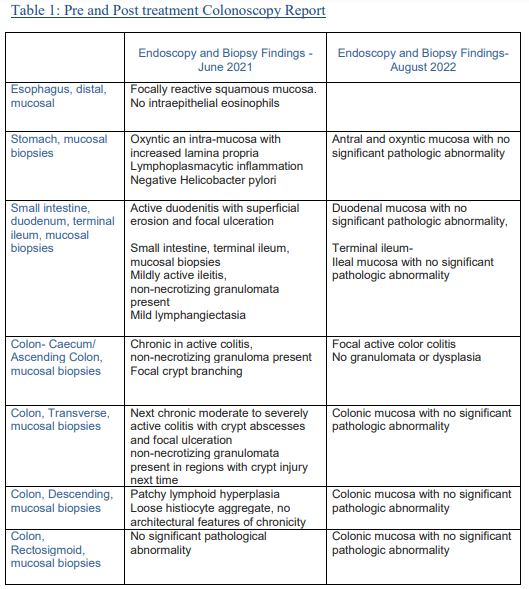
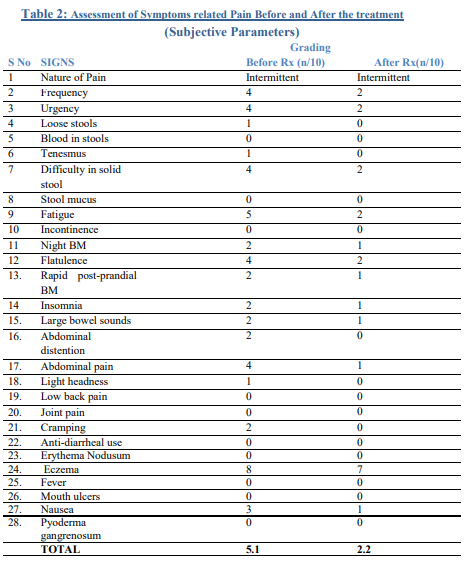
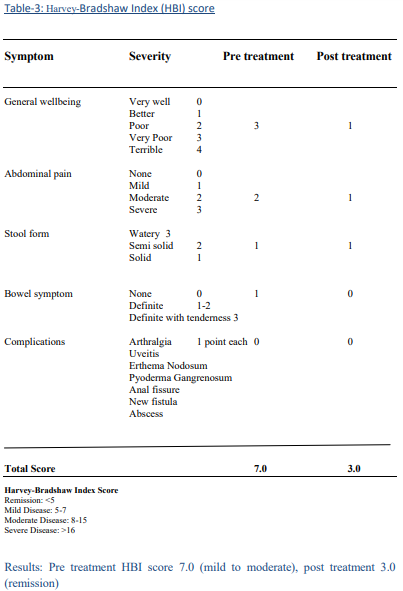
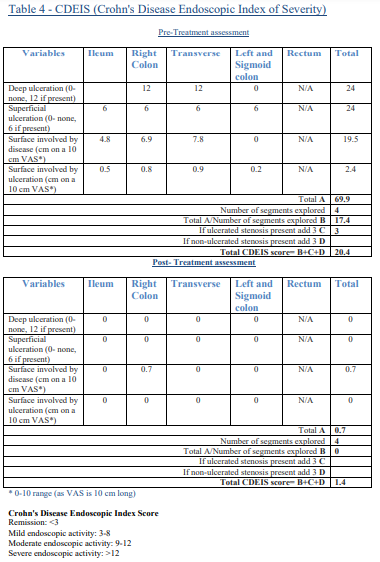
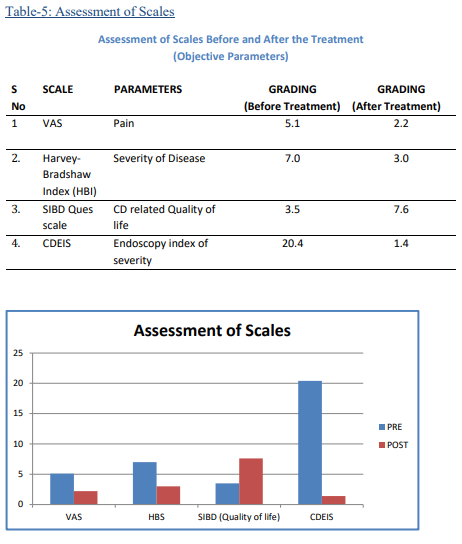
© 2023 by Chakrasiddh. All Rights Reserved.